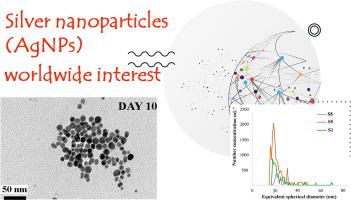Gondwana Research ( IF 6.1 ) Pub Date : 2021-07-17 , DOI: 10.1016/j.gr.2021.07.012 Azibar Rodriguez-Iruretagoiena 1 , Margaret Graham 2 , Ainara Gredilla 3 , Silvia Fdez-Ortiz de Vallejuelo 1 , Geert Cornelis 4 , Helfrid Schulte-Herbrüggen 5 , Juan Manuel Madariaga 1 , Alberto de Diego 1

|
Silver nanoparticles (AgNPs) are highly produced in developed countries for a variety of products. Consequently, AgNPs end up being introduced in aquatic systems all over the world, and usually deposited in riverine sediments, from where they can be taken up by aquatic organisms and transferred along the food chain. The analysis of AgNPs in natural samples is not an easy task, because of their low presence and complicated reactions, which can change their speciation. The objective of this work is to help in this challenge, developing a method applicable to analyse sediment samples from any place around the world where AgNPs are suspected to be present.
Firstly, four methods for the synthesis of AgNPs were investigated by Ultraviolet-visible (UV-VIS) spectroscopy and particle size analysis. The methods differed in the reducing agent used and in the concentration of the stabilising agent applied. The method including NaBH4 and SDS (sodium dodecyl sulphate) resulted to be more adequate as the Surface Plasmon Resonance (SPR) band position and width indicated. This conclusion was corroborated considering the hydrodynamic diameters and polydispersity indices of the synthesised AgNPs. The Z-average hydrodynamic diameter and the UV-VIS spectrum of AgNPs synthesised using this method indicated that the AgNPs remained kinetically stable for at least 10 days.
Finally, ten potential extraction solutions were investigated, in terms of maximal extraction efficiency, but minimal effects on AgNP dissolution and aggregation. The candidate solutions ranged from deionized water and salts to strong acids and bases. The intensity of the SPR band concluded that using NaOH media the synthesised AgNPs was kinetically stable. Moreover, TEM (Transmission Electron Microscopy) images showed that the AgNPs in NaOH retained their shape and size after 10 days. Therefore, NaOH media turned out to be the best potential extractant for the analysis of sediment samples.
中文翻译:

一种量化沉积物中银纳米粒子的新程序
银纳米粒子 (AgNPs) 在发达国家大量生产用于各种产品。因此,AgNPs 最终被引入世界各地的水生系统,通常沉积在河流沉积物中,水生生物可以从那里吸收并沿着食物链转移。分析天然样品中的 AgNPs 并不是一件容易的事,因为它们的含量低且反应复杂,这会改变它们的形态。这项工作的目的是帮助应对这一挑战,开发一种适用于分析来自世界各地怀疑存在 AgNPs 的任何地方的沉积物样本的方法。
首先,通过紫外-可见(UV-VIS)光谱和粒度分析研究了四种合成AgNPs的方法。这些方法的不同之处在于所用的还原剂和所用稳定剂的浓度。如表面等离子体共振 (SPR) 带位置和宽度所示,包括 NaBH 4和 SDS(十二烷基硫酸钠)的方法更合适。考虑到合成的 AgNPs 的流体动力学直径和多分散指数,这一结论得到了证实。使用这种方法合成的 AgNPs 的 Z 平均流体动力学直径和 UV-VIS 光谱表明 AgNPs 保持动力学稳定至少 10 天。
最后,就最大提取效率而言,研究了十种潜在的提取解决方案,但对 AgNP 溶解和聚集的影响最小。候选溶液的范围从去离子水和盐到强酸和强碱。SPR 带的强度得出结论,使用 NaOH 介质合成的 AgNPs 在动力学上是稳定的。此外,TEM(透射电子显微镜)图像显示 NaOH 中的 AgNPs 在 10 天后保持其形状和大小。因此,NaOH 介质被证明是分析沉积物样品的最佳潜在萃取剂。

























 京公网安备 11010802027423号
京公网安备 11010802027423号